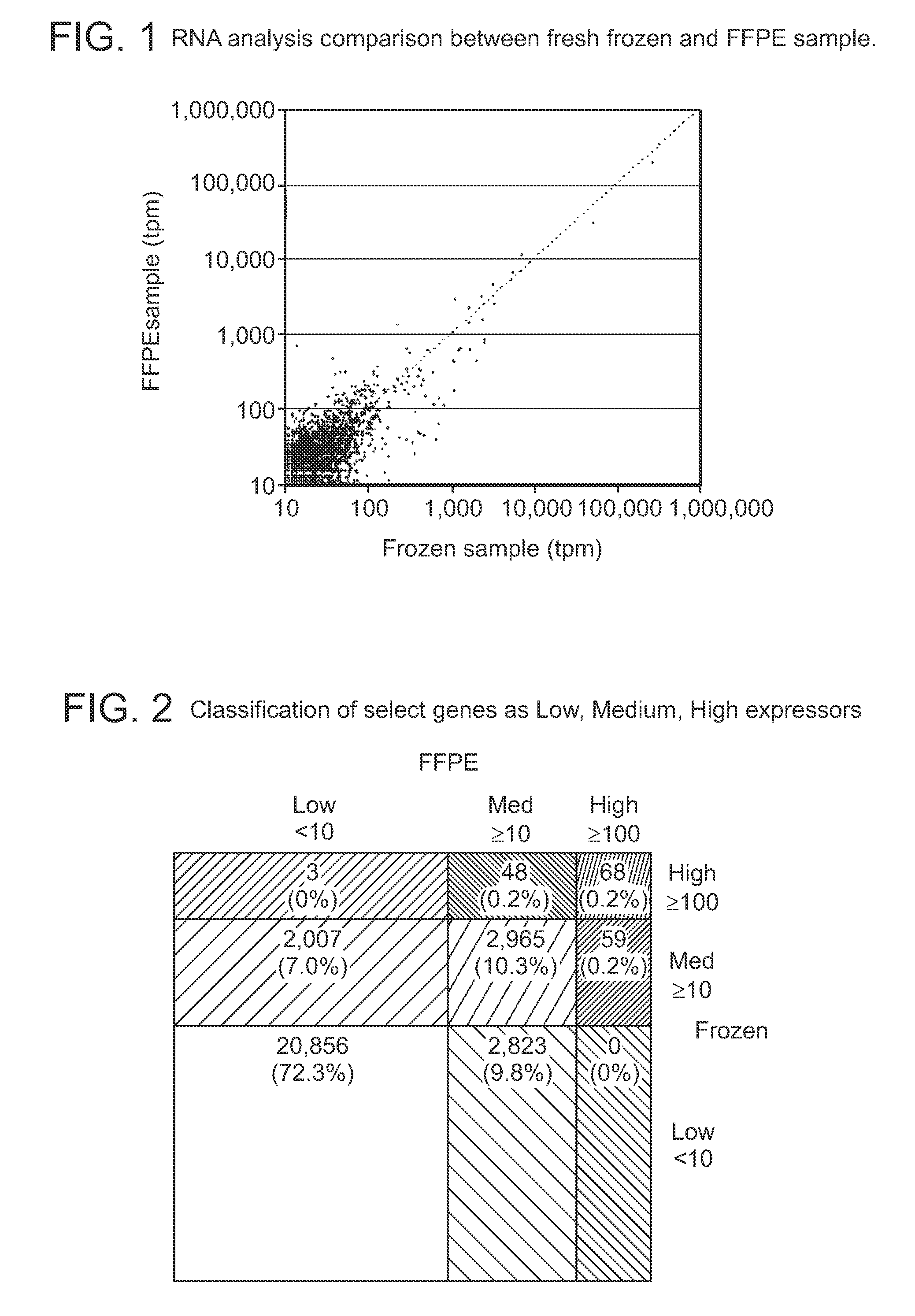Methods for sequencing degraded or modified nucleic acids
a nucleic acid and degraded technology, applied in the field of molecular biology, can solve the problems of negative affecting the ability to sequence dna using other methodologies, and achieve the effect of improving the characterization of disease/treatment status and high throughpu
- Summary
- Abstract
- Description
- Claims
- Application Information
AI Technical Summary
Benefits of technology
Problems solved by technology
Method used
Image
Examples
example 1
FFPE Samples
[0043]Nucleic acid can be purified from FFPE blocks using any standard technique. The nucleic acid can be used directly or, in the case of RNA, may be reverse transcribed to cDNA prior to further manipulation. Reverse transcription can be primed with a variety of different oligonucleotides or self-priming polymerases. Short oligonucleotides consisting of mixed hexamers are frequently used and may be a completely random assortment or may be selected to include only a specific subset of oligonucleotides so as to preferentially prime RNA species of higher interest. The RNA may be treated before or after cDNA synthesis so as to remove less interesting RNA molecules such as ribosomal or mitochondrial RNA. The DNA, RNA, or cDNA samples may be reacted with terminal transferase and dATP or other suitable nucleotide triphosphate to add a tail at the 3′ end sufficiently long to allow specific hybridization to a complementary homopolymer capture sequence. This reaction may be contr...
example 2
Single Molecule Sequencing
[0044]Epoxide-coated glass slides are prepared for oligo attachment. Epoxide functionalized 40 mm diameter #1.5 glass cover slips (slides) are obtained from Erie Scientific (Salem, N.H.). The slides are preconditioned by soaking in 3×SSC for 15 minutes at 37° C. Next, a 500-pM aliquot of 5′ aminated capture oligonucleotide (oligo dT(50)) is incubated with each slide for 30 minutes at room temperature in a volume of 80 ml. The slides are then treated with phosphate (1 M) for 4 hours at room temperature in order to passivate the surface. Slides are then stored in 20 mM Tris, 100 mM NaCl, 0.001% Triton® X-100, pH 8.0 at 4° C. until they are used for sequencing.
[0045]For the illustration of the sequencing process, see, e.g., U.S. patent application Ser. Nos. 12 / 043,033 (Xie et al. filed Mar. 5, 2008) and U.S. Ser. No. 12 / 113,501 (Xie et al. filed May 1, 2008) (e.g., FIGS. 1A and 1B). For sequencing, the slide is assembled into a 25 channel flow cell using a 50-...
PUM
| Property | Measurement | Unit |
|---|---|---|
| diameter | aaaaa | aaaaa |
| volume | aaaaa | aaaaa |
| temperature | aaaaa | aaaaa |
Abstract
Description
Claims
Application Information
 Login to View More
Login to View More - R&D
- Intellectual Property
- Life Sciences
- Materials
- Tech Scout
- Unparalleled Data Quality
- Higher Quality Content
- 60% Fewer Hallucinations
Browse by: Latest US Patents, China's latest patents, Technical Efficacy Thesaurus, Application Domain, Technology Topic, Popular Technical Reports.
© 2025 PatSnap. All rights reserved.Legal|Privacy policy|Modern Slavery Act Transparency Statement|Sitemap|About US| Contact US: help@patsnap.com


